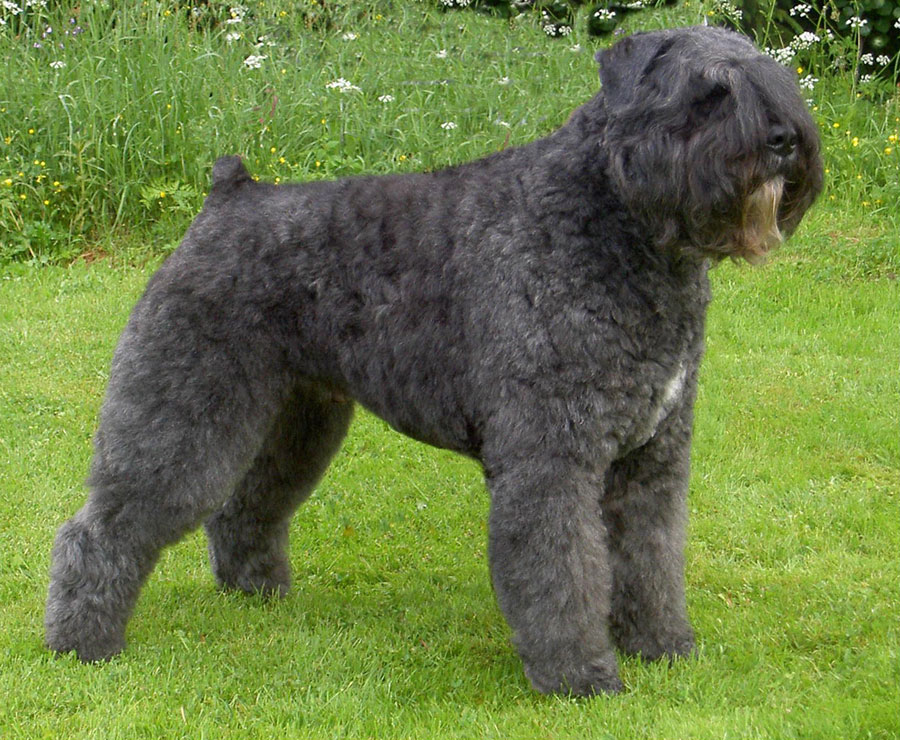
Bouvier Des Flandres

Navigate through the tabs
Navigate through the tabs below to view the breed's info of your interest.
The breed's info is divided in four sections; namely:
the breed's history ,
the breed's main stats ,
the dog's potential health issues
and finally, how the breed scored in 26 different categories.
All the above information should give you a respectively good overview for the dog of your interest.
Dog Breed's Main Info
The Breed's History:
The monks at the Ter Duinen monastery in Flanders were among the earliest known breeders of Flanders. The bouviers bred by them are recorded as having been bred from imports such as Irish wolfhounds and Scottish deerhounds with local farm dogs, until a breed considered to be the predecessor of the modern Bouvier des Flandres was obtained.
This became a working dog able to perform tirelessly, herding and guarding cattle and even pulling cargo carts, thanks to its strength and temperament, and to withstand the local weather conditions due to its thick coat.
Historically, the ear cropping and tail docking could have been done for practical reasons, avoiding accidental amputations in the course of work, or to indicate the dog was working stock and not a pet subject to taxation.
Up until the early 20th century, the breed was not completely defined, with three variants:
Paret, Moerman or Roeselare, and Briard. Conflict between the proponents of these three variants held the breed's development back. In 1912 and 1913, several local kennel clubs recognized standards for Bouviers; however they usually had different standards for the Roeselare and other variants.
World War I nearly caused the breed to disappear, due to the devastation that came over its region of origin and the fact that the dogs were used for military purposes.
Indeed, Nic, a male trained as a trench dog who served during the war and was a perennial winner at dog shows after the war, is considered to be the founder of the early Bouvier des Flandres breed.
A unified Bouvier des Flandres standard was created in 1936 by a joint French-Belgian committee. However, World War II again endangered the breed's existence. Due to these setbacks, progress was slowed, and it was not until 1965 that the Federation Cynologique Internationale (FCI) breed standard, as agreed to by several minor kennel clubs, was adopted.
Country of Origin:
Belgium
Breed Group:
Herding
Height:
1 foot, 11 inch to 2 feet, 4 inch. (58,42 to 71,12 cm)
Weight:
70 to 100 pounds (31,75 to 45,36 Kg)
Life Span:
10 to 12 years
Potential Health Issues:
Hip Dysplasia,
Elbow Dysplasia,
Cataracts,
Cancer,
Glaucoma,
Ectropion,
Hypothyroidism,
Epilepsy,
Gastric Torsion,
Addison's Disease,
Cushing's Disease
Adaptability
Apartment Living:
First Time Owners:
Sensitivity:
Being Alone:
Cold Weather:
Hot Weather:
Friendliness
Affection With Family:
With Kids:
With Dogs:
With Strangers:
Health and Grooming
Shedding:
Drooling:
Easy To Groom:
Overall Health:
Weight Gain Potential:
Size:
Training
Easiness:
Intelligence:
Mouthiness:
Prey Drive:
Barking or Howling:
Wanderlust:
Need For Exercise
Energy Level:
Intensity:
Exercise Needs:
Playfulness:
Our Mobile Application
Check out Our Mobile Application "Dog Breeds Central"
